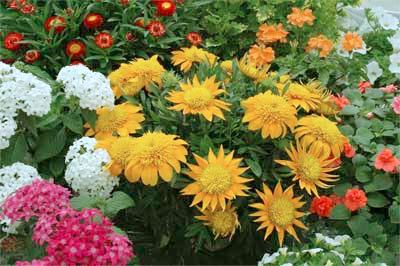
Plant of the Month: Gazania
Sunbathers
Gazania ‘Sunbather’ series
AT A GLANCE
Latin name: Gazania ‘Sunbather’ series
Common name: Gazania
Flowers: Large semi-double daisies in shades of orange, yellow or white
Mature size: 12” tall by 15” wide
Hardiness: Perennial to USDA Zone 8
Soil: Well-drained
Exposure: Full sun
Water usage: Low
Sources: Local nurseries
I have to admit I really like gazanias. Unfortunately, I’ve been constantly disappointed by their lack of performance here in Texas. As soon as it gets hot, they wither up and die – or did until we discovered the new ‘Sunbather’ series of gazania from Ecke. These have performed exceptionally well for us — surprisingly well, even in the worst heat of the summer.
‘Sunbather’ gazania is available in four colors: ‘Malibu’, a rich orange-gold color; ‘Gold Coast’, a deep yellow; ‘Sunset’, dark bronze orange; and ‘Moonlight’, a pale yellow to creamy white. What you first notice about these gazanias is that they bear huge semi-double flowers that can reach almost 6 inches across during cooler weather. Since the flowers feature mounds of petals in the center, they can’t close up completely in the evening like the other varieties. ‘Sunbather’ gazania is also more vigorous and larger than any variety we’ve tested. Plants (with flowers) will top out around 12 inches tall and spread to 15 inches across. The foliage is very thick and somewhat succulent.
I recommend planting them in fall or early spring. The flowers and foliage are cold hardy to below freezing, but will freeze completely back to the ground if unprotected during periods of low 20s. You’ll have to buy these at your local nursery or via the Internet; since they are cutting-propagated, you will not be able to grow them from seed.
‘Sunbather’ has done best for us in full sun in containers or in very well drained soil. If there is one trick to these plants, it is to not allow them to sit in water, as they will rot quickly. Our plants have survived the last few winters in the mild Zone 8 weather of the Dallas Arboretum. If you live in a colder area, grow them as spring to fall annuals, or bring them into your garage during the winter.
